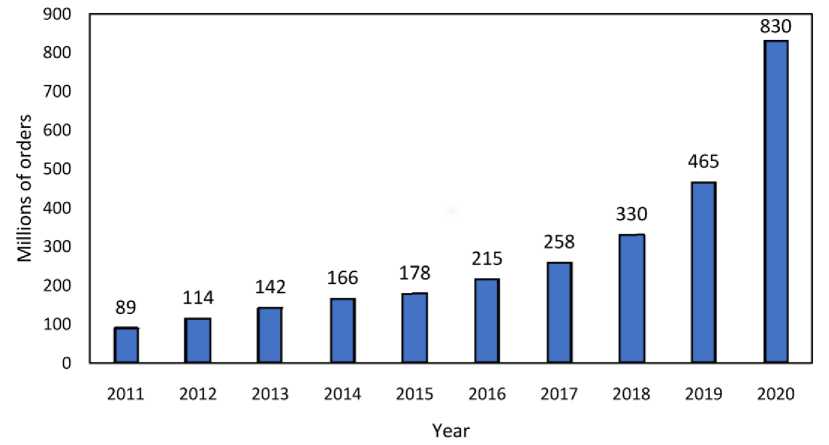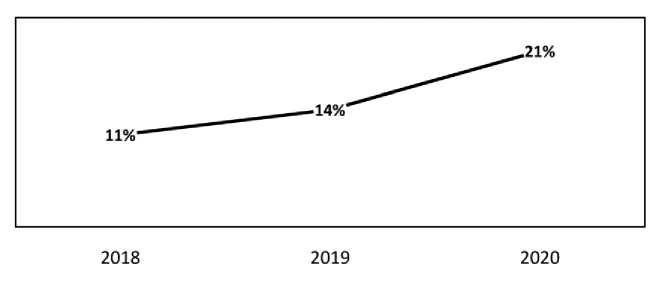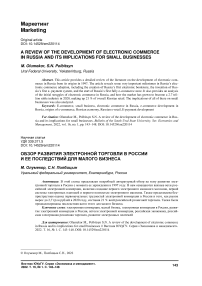A review of the development of electronic commerce in Russia and its implications for small businesses
Бесплатный доступ
This article provides a detailed review of the literature on the development of electronic commerce in Russia from its origins in 1997. The article reveals some very important milestones in Russia’s electronic commerce adoption, including the creation of Russia’s first electronic bookstore, the invention of Russia’s first e-payment system, and the start of Russia’s first fully e-commerce store. It also provides an analysis of the initial struggles of electronic commerce in Russia, and how the market has grown to become a 2.7 trillion ruble industry in 2020, making up 21 % of overall Russian retail. The implications of all of these on small businesses was also analyzed.
E-commerce, small business, electronic commerce in Russia, e-commerce development inrussia, origins of e-commerce, russian economy, russian e-retail, e-payment development
Короткий адрес: https://sciup.org/147237395
IDR: 147237395 | УДК: 339.371.5
Текст научной статьи A review of the development of electronic commerce in Russia and its implications for small businesses
Electronic commerce, also known as ecommerce, online commerce or digital trade, has become an increasingly dominant part of the Russian and global economy. Chaffey (2007) defines electronic commerce as all “types of transactions between organizations and stakeholders whether they are financial transactions or exchanges of information or other services”, while Holsapple and Singh (2000) synthesized the several disparate aspects of electronic commerce to produce a seamless definition which takes into account the “trading view, the information exchange view, the activity view, the effects view, and the value chain view” of electronic commerce. Applegate et al. (1996) argued that electronic commerce involves more than simply buying and selling over the internet, and it also includes “all sorts of presale and postsale efforts”, and a number of other factors including “market research, generation of qualified sales leads, advertising, product purchasing and distribution, customer support, recruiting, public relations, business operations, production management, knowledge distribution, and financial transactions”.
However, perhaps the most comprehensive definition of electronic commerce was presented by Rolf T. Wigand (1997), who explained electronic commerce as any form of economic activity conducted through electronic connections. He further argued that electronic commerce covers a wide spectrum including electronic markets, electronic hierarchies, electronically supported entrepreneurial networks and electronic networks. He also included commonly available services in tourism, finance, insurance, product distribution and customer services as part of electronic commerce (Wigand, 1997). Today, electronic commerce has also come to include digital advertising, social media commerce, online gambling and online brand development, among others.
This article explores the development of electronic commerce in Russia by examining relevant literature and data on the subject.
Importance of E-commerce
The global e-commerce sector was a $1.3 trillion industry in 2014, and by 2020 it had almost quadrupled in size with a revenue of $4.28 trillion. It is expected to continue its huge growth into the future with revenues of $5.4 trillion in 2022 and $6.5 trillion in 2023 (Statista, 2020). According to research from Data Insights (2021b), the Russian e-commerce market grew by 78 % in 2020, making Russia one of the fastest growing e-commerce markets in the world.
The importance of a thriving e-commerce market to the economy of a country has been well documented by several scholars, including Liu (2013), who argued that e-commerce can be a vital tool to growing the economy of a country, and Molla and Heeks (2007) who extolled the role e-commerce could play in improving the economies of developing nations. Furthermore, e-commerce also has the ability to improve trade for countries (World Trade Organization, 2013), to help business increase sales especially in moments of crisis (Yun et al., 2020), for business expansion (Xia & Zhang, 2010), for education (Goldsmith & McGregor, 2000; Olumekor, 2021) and to help small and medium enterprises become more competitive (Grandon & Pearson, 2004; Karagozoglu & Lindell, 2004; Kurnia et al., 2015; Lucking-Reiley & Spulber, 2001; Min & Galle, 1999; Subba Rao et al., 2003).
Development of Electronic commerce
The history of modern e-commerce can be traced back to the development of computers going back to the late 1940s and early 1950s (Smith, K.T. 2008). According to the Smithsonian Magazine (2015), the world’s first genuine e-commerce transaction occurred when Dan Kohn, founder of NetMarket sold a CD of Sting’s “Ten Summoner’s Tales” to his friend in Philadelphia, who paid $12.48 plus shipping, and “used data encryption software to send his credit card number securely”.
Development of Electronic Commerce in Russia
In Russia, e-commerce began in 1996 after ‘Symvol Plus’, the Russian book publishing company, created its electronic store to sell books in all of Russia. It was created to mirror Amazon, the American bookstore which was created two years earlier in 1994. In 1997, Symvol Plus changed the name of its electronic store to ‘Books.ru’, a website which still sells books till today. About one year after the creation of Books.ru, Ozon.ru – also simply referred to as Ozon – was created to also sell books via the internet. However, unlike Books.ru which has largely remained an online bookstore, Ozon expanded into selling electronics, toys, CDs and DVDs, and eventually many
Table 1
Some major milestones in the development of internet and e-commerce
|
Year |
Milestone |
|
1946 |
The first computer was developed by the University of Pennsylvania |
|
1958 |
ARPA – The Advanced Research Projects Agency is created in the United States of America |
|
1969 |
ARPANET, the precursor to the modern internet is created |
|
1970 |
The adoption of Electronic Data Interchange begins. |
|
1972 |
The first internet transaction between students at Stanford University and MIT |
|
1974 |
ARPANET is commercialised by Bolt Beranek and Newman, and Telnet is created |
|
1982 |
Transmission Control Protocol (TCP) and Internet Protocol (IP) are created and the term “Internet” becomes widely used |
|
1989 |
The internet reaches 100000 users |
|
1992 |
The World Wide Web (www) is formally released. |
|
1994 |
Dan Kohn conducts the first fully e-commerce transaction using data encryption software |
|
2000 |
The internet reaches 360 million global users |
|
2014 |
E-commerce sales surpass $1.3 trillion globally |
|
2021 |
The Internet surpasses 5.1 billion users |
Sources: Smith K.T. (2009), Smith et al. (2010), Smithsonian Magazine (2015), Internet World Stats (2021), Statista (2020).
other products (Hawk, 2002). Today, Ozon is a fully fledged e-commerce company selling almost every type of consumer good, and in 2020 it completed its Initial Public Offering with a valuation of over $6.2 billion (Bloomberg, 2020).
The case of Ozon is not an outlier in global and Russian e-commerce. According to Statista (2021), 2.14 billion people are expected to buy goods and services over the internet in 2021. That represents an extraordinary amount of growth compared to 2016, when 1.66 billion were e-commerce customers. Various scholars argue about the different reasons fuelling the growth of e-commerce; however, it is undeniable that growth in e-commerce has coincided with the growth in the number of internet users, especially the astronomical growth in mobile internet usage. According to Kemp (2021), as of January 2021, there were 226.6 million mobile connections, and data from the World Bank (2020) show more than 82.6 % of the Russian population used the internet in 2019, compared to just 49 % in 2011. During the same time pe- riod, e-commerce sales increased from just 89 million orders in 2011, to over 830 million orders in 2020 (Data Insights, 2021b).
Further research from Data Insights (2021b) show the current size of the Russian e-commerce sector to be 2.7 trillion rubles, while the share of electronic commerce has risen to 21 % of overall retail sales in Russia, compared to just 11 % in 2018.
However, similar to the experiences of other countries, e-commerce in Russia faced some initial challenges during its infancy. The first major challenge was how to handle payment for goods bought electronically. Due to the low usage of credit cards between 1997 and 2001 in Russia, e-commerce stores adopted a system of enabling customers to either pay cash on delivery or pay via bank wire transfer. The complexity of this system led to the rise of Russia’s first electronic payment system, CyberPlat. Cyberplat was created by Platina bank in 1998 and completed its first electronic commerce transaction in August of the same year (Kommersant, 2000). The invention of

Figure 1. Number of Orders in electronic commerce in Russia Data Source: Data Insights, (2021b)

Figure 2. Share of E-commerce in Russian retail Data Source: Data Insights, (2021b)
Cyberplat – and subsequently other e-payment solutions like WebMoney – was a significant milestone in the development of electronic commerce in Russia (Hawk, 2002). Furthermore, another initial challenge during the early periods of e-commerce in Russia, was how to handle logistics and product delivery. Russia is famous for its vast terrain, and delivering goods all over the country all year round – including during the harsh winter season – proved to be difficult (Hawk, 2002). Nevertheless, electronic commerce companies overcame this problem by building their own logistics and delivery systems.
Most major stores in Russia currently offer some form of opportunity for customers to buy their products online. Figures from Data Insights (2021a) show the leading e-commerce company in Russia to be Wildberries with a revenue of 413 billion roubles in 2020, this represented about double its revenue in 2019. Furthermore, Wildberries has also expanded its operations beyond Russia and the Commonwealth of Independent States. It now has a presence in Poland,
Implications for small businesses
As more industries and customers in the Russian economy accelerate their movement towards electronic commerce and economic digitalisation, it is important to note that the initial stages can be highly disruptive for small businesses in particular. In an extensive study of the effect of electronic commerce and overall digitalisation, Scholz et al. (2020) found that businesses could be vulnerable to digital threats and proposed a method to quantitatively analyse and overcome this. Furthermore,
Olumekor M., Polbitsyn S.N.
extensive studies on different areas of electronic commerce and overall digitalisation have been linked to future unemployment, and challenges for businesses and the larger economy (Arntz et al., 2017; Frey and Osborne, 2017; Sorgner et al., 2017).
However, the overwhelming body of research suggests that electronic commerce can be beneficial to small businesses in the long run (Subba Rao et al., 2003; Chen & Zhang, 2015; Tan & Ludwig, 2016; Grandón & Ramírez-Correa, 2018;
Conclusion
This article provides a detailed review of current literature on the development of electronic commerce in Russia from its origins in 1997 to today. We traced the development of e-commerce in Russia from its founding in 1997, to the 2.7 trillion ruble industry that it is today. We uncovered many noteworthy milestones including the creation of ‘Symvol Plus’ in 1997 which became Books.ru, to the creation of Ozon which became Russia’s first general e-commerce store, and the creation of CyberPlat, which provided Russia’s first e-payment service and helped ease a lot of challenges with financial transactions in the early periods of Russian electronic commerce. As electronic commerce accelerates in Russia, we analysed its implications for small businesses
The main limitation of this study is that it is limited in scope and does not cover the changes in investments and governmental policies – including taxes – which have increased the growth of electronic commerce in Russia. Therefore, additional research on the topic is highly encouraged.
Список литературы A review of the development of electronic commerce in Russia and its implications for small businesses
- Applegate, L. M., Holsapple, C. W., Kalakota, R., Radermacher, F. J., & Whinston, A. B. (1996). Electronic commerce: Building blocks of new business opportunity. Journal of Organizational Computing and Electronic Commerce, 6(1), 1-10. https://doi.org/10.1080/10919399609540264
- Bloomberg. (2020). Online Retailer Ozon Has Best Russia IPO Debut Since 2011. Www.bloomberg.com. https://www.bloomberg.com/news/articles/2020-11-25/online-retailer-ozon-has-best-russia-ipo-debut-since-2011
- Chaffey, D. (2007). E-business and e-commerce management: strategy, implementation and practice. Financial Times Prentice Hall. https://dl.acm.org/citation.cfm?id=1213572
- Data Insights. (2021a). T0n-100 2019. Top-100 2019. https://www.top100.datainsight.ru/ Data Insights. (2021b). E-commerce in Russia 2020. In Data Insights. https://datainsight.ru/ sites/default/files/DI_Ecommerce2020_eng.pdf
- East-West Digital News. (2021, May 28). In 2020, Russian e-commerce recorded one of the world's highest growth rates. East-West Digital News. https://www.ewdn.com/2021/05/28/in-2020-russia-recorded-one-of-the-worlds-highest-e-commerce-growth-rates/
- Goldsmith, E., & McGregor, S. L. T. (2000). E-commerce: consumer protection issues and implications for research and education. Journal of Consumer Studies and Home Economics, 24(2), 124-127. https://doi.org/10.1046/j.1365-2737.2000.00150.x
- Grandon, E. E., & Pearson, J. Michael. (2004). Electronic commerce adoption: an empirical study of small and medium US businesses. Information & Management, 42(1), 197-216. https://doi.org/10.1016/jim.2003.12.010
- Hawk, S. (2002). The development of Russian e-commerce: the case of Ozon. Management Decision, 40(7), 702-709. https://doi.org/10.1108/00251740210438535
- Holsapple, C. W., & Singh, M. (2000). Electronic Commerce: From a Definitional Taxonomy Toward a Knowledge-Management View. Journal of Organizational Computing and Electronic Commerce, 10(3), 149170. https://doi.org/10.1207/s15327744joce1003_01
- Internet World Stats. (2021). World Internet Users Statistics and 2019 World Population Stats. Internetworldstats.com. https://www.internetworldstats.com/stats.htm
- Karagozoglu, N., & Lindell, M. (2004). Electronic commerce strategy, operations, and performance in small and medium-sized enterprises. Journal of Small Business and Enterprise Development, 11(3), 290-301. https://doi.org/10.1108/14626000410551555
- Kemp, S. (2021, February 11). Digital in Russia: All the Statistics You Need in 2021. DataReportal - Global Digital Insights. https://datareportal.com/reports/digital-2021-russian-federation
- Kommersant. (2000, May 25). CyberPlat отпустили на волю. Www.kommersant.ru. https://www.kommersant.ru/doc/148818?query=cyberplat
- Kurnia, S., Choudrie, J., Mahbubur, R. M., & Alzougool, B. (2015). E-commerce technology adoption: A Malaysian grocery SME retail sector study. Journal of Business Research, 68(9), 1906-1918. https://doi.org/10.1016/jjbusres.2014.12.010
- Liu, S. (2013). An Empirical Study on E-commerce's effects on Economic Growth. Proceedings of the 2013 Conference on Education Technology and Management Science. https://doi.org/10.2991/icetms.2013.260
- Lucking-Reiley, D., & Spulber, D. F. (2001). Business-to-Business Electronic Commerce. Journal of Economic Perspectives, 15(1), 55-68. https://doi.org/10.1257/jep.15.L55
- Min, H., & Galle, W. P. (1999). Electronic commerce usage in business-to-business purchasing. International Journal of Operations & Production Management, 19(9), 909-921. https://doi.org/ 10.1108/01443579910280232
- Molla, A., & Heeks, R. (2007). Exploring E-Commerce Benefits for Businesses in a Developing Country. The Information Society, 23(2), 95-108. https://doi.org/10.1080/01972240701224028
- Olumekor, M. O. (2021). A Comparative Study of Higher Educational Institutions in Russia and England: Analyzing the Fulfilment Levels of Students. Lecture Notes in Networks and Systems, 2(1), 1011-1019. https://doi.org/10.1007/978-3-030-80485-5_113
- Olumekor, M., & Polbitsyn, S. (2021). COVID-19 AND CONSUMER BEHAVIOUR: A REVIEW OF RECENT LITERATURE. Bulletin of South Ural State University Series "Economics and Management," 15(3), 183-189. https://doi.org/10.14529/em210319
- Smith, K. T. (2008). An Analysis of E-Commerce: E-Risk, Global Trade, and Cybercrime. SSRN Electronic Journal, https://doi.org/10.2139/ssrn.1315423
- Smith, K. T., Smith, M., & Smith, J. L. (2010, December 13). Case Studies of Cybercrime and its Impact on Marketing Activity and Shareholder Value. Papers.ssrn.com. https://ssrn.com/abstract=1724815
- Smithsonian Magazine. (2015, November 30). What Was the First Thing Sold on the Internet? Smithsonian; Smithsonian.com. https://www.smithsonianmag.com/smart-news/what-was-first-thing-sold-internet-180957414/ Statista. (2020, November 30). Global Retail E-Commerce Market Size 2014-2021. Statista; Statista. https://www.statista.com/statistics/379046/worldwide-retail-e-commerce-sales/
- Statista. (2021). Digital buyers worldwide 2021 | Statistic. Statista; Statista. https://www.statista.com/ statis-tics/251666/number-of-digital-buyers-worldwide/
- Subba Rao, S., Metts, G., & Mora Monge, C. A. (2003). Electronic commerce development in small and medium sized enterprises. Business Process Management Journal, 9(1), 11-32. https://doi.org/ 10.1108/14637150310461378
- WIGAND, R. T. (1997). Electronic Commerce: Definition, Theory, and Context. The Information Society, 13(1), 1-16. https://doi.org/10.1080/019722497129241
- World Bank. (2020). Individuals using the Internet ( % of population) - Russian Federation | Data. Da-ta.worldbank.org. https://data.worldbank.org/indicator/IT.NET.USER.ZS?locations=RU
- World Trade Organization. (2013). WTO | Publications. Www.wto.org.https://www.wto.org/english/res_e/ publications_e/ecom_devel_countries_e.htm
- Xia, Y., & Zhang, G. P. (2010). The Impact of the Online Channel on Retailers' Performances: An Empirical Evaluation. Decision Sciences, 41(3), 517-546. https://doi.org/10.1111/j.1540-5915.2010.00279.x


